Plasma Turbulence at Comet 67P/Churyumov-Gerasimenko: Rosetta Observations
- PMID: 34381663
- PMCID: PMC8350962
- DOI: 10.1029/2020ja028100
Plasma Turbulence at Comet 67P/Churyumov-Gerasimenko: Rosetta Observations
Abstract
We perform a power spectral analysis of magnetic field fluctuations measured by the Rosetta spacecraft's magnetometer at comet 67P/Churyumov-Gerasimenko. We interpret the power spectral signatures in terms of plasma turbulent processes and discover that different turbulent processes are prominent during different active phases of the comet. During the weakly active phase of the comet, dominant injection is prominent at low frequencies near 10-2 Hz, while partial energy cascade or dispersion is prominent at high frequencies near 10-1 Hz. During the intermediately active phase, uniform injection is prominent at low frequencies, while partial energy cascade or dispersion is prominent at high frequencies. During the strongly active phase of the comet, we find that partial energy cascade or dissipation is dominant at low frequencies, while partial energy cascade, dissipation, or dispersion is dominant at high frequencies. We infer that the temporal variations of the turbulent processes occur due to the evolution of the plasma environment of the comet as it orbits the Sun.
Figures
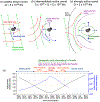
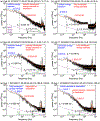
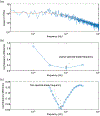

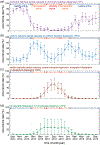
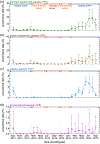
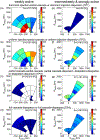

References
-
- Alexandrova O, Carbone V, Veltri P, & Sorriso-Valvo L (2008). Small-scale energy cascade of the solar wind turbulence. The Astrophysical Journal, 674, 1153–1157. 10.1086/524056 - DOI
-
- Alexandrova O, Lacombe C, Mangeney A, Grappin R, & Maksimovic M (2012). Solar wind turbulent spectrum at plasma kinetic scales. The Astrophysical Journal, 760, 121. 10.1088/0004-637X/760/2/121 - DOI
-
- Behar E, Lindkvist J, Nilsson H, Holmström M, Stenberg-Wieser G, Ramstad R, & Götz C (2016). Mass-loading of the solar wind at 67P/Churyumov-Gerasimenko: Observations and modeling. Astronomy & Astrophysics, 596, A42. 10.1051/0004-6361/201628797 - DOI
-
- Behar E, Nilsson H, Alho M, Goetz C, & Tsurutani B (2017). The birth and growth of a solar wind cavity around a comet—Rosetta observations. Monthly Notices of the Royal Astronomical Society, 469, S396–S403. 10.1093/mnras/stx1871 - DOI
-
- Behar E, Nilsson H, Stenberg-Wieser G, Nemeth Z, Broiles TW, & Richter I (2016). Mass loading at 67P/Churyumov-Gerasimenko: A case study. Geophysical Research Letters, 43, 1411–1418. 10.1002/2015GL067436 - DOI
Grants and funding
LinkOut - more resources
Full Text Sources
